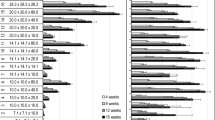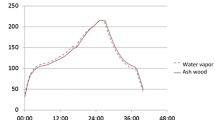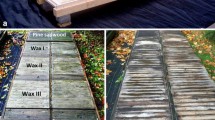Abstract
The use of wood is limited due to its susceptibility to wood destroying organisms. If wet for long periods, wood will be attacked by fungi and the strength properties will decrease dramatically. To overcome this disadvantage, non-durable wood can be treated with preserving chemicals. When testing durability, it is essential that wood be exposed to all kinds of wood degrading organisms that can be expected in the intended exposure environment.
The aim of this study was to evaluate the relevance of exposing test ttakes in terrestrial microcosms (TMC) as an alternative to existing test procedures to judge the durability of treated and untreated wood.
Small stakes of treated and untreated pine (Pinus sylvestris) sapwood were exposed in TMCs with different soils. Stakes were also exposed to pure cultures of brown and white rot fungi.
After exposure, mass losses were determined and stakes from the TMCs were analysed using light microscopy to determine the types of microbial attack.
The effect of the preservatives varied depending on the exposure environment.
It is concluded that testing the durability of untreated and treated wood with pure cultures of fungi is too limited a test to evaluate total effectiveness. Testing in TMCs represents a good complement to existing procedures and, after further development, an alternative to other laboratory and field tests.
Résumé
La vulnérabilité du bois aux micro-organismes est un facteur qui limite son usage. Lorsqu'il est mouillé pendant une période prolongée, le bois sera attaqué par des champignons, ce qui diminuera dramatiquement sa résistance. Pour pallier à ce désavantage, on peut traiter les bois les moins résistants avec des produits de préservation. Afin d'évaluer sa durabilité après traitement, il est alors essentiel d'exposer le bois à tous les types d'organismes destructeurs pouvant se trouver dans le milieu où il sera utilisé.
Le but de cette étude est d'évaluer l'exposition des piquets de bois dans des microcosmes terrestres, en tant qu'essai alternatif aux procédures existantes pour évaluer la résistance des bois traités et non traités.
Des petits piquets de pin sylvestre, Pinus sylvestris, traités et non traités, ont été exposés à des microcosmes terrestres, utilisant des sols différents. Les piquets ont également été exposés à des cultures pures de champignons de carie blanche et de carie brune.
Après l'essai, les pertes de masse ont été déterminées et les piquets ont été analysés au microscope photonique afin d'identifier le type d'attaque microbienne subie.
L'effet des produits de préservation a varié selon le milieu auquel les bois traités ont été exposés.
On a conclu que des essais de durabilité effectués sur des bois traités et non traités, uniquement en présence de cultures pures de champignons, sont trop limités pour prédire l'efficacité totale d'un produit de préservation. Les essais effectués dans des microcosmes terrestres peuvent être un bon complément aux procédures existantes. Ils peuvent même devenir, après des recherches supplémentaires, une alternative à d'autres essais sur le terrain et en laboratoire.
Similar content being viewed by others
References
CEN, ‘EN 350-2. Durability of wood and wood-based products. Part 2: Guide to natural durability and treatability of selected wood species of importance in Europe’, European Committee for Standardisation (1994).
Kamesan S., ‘Process for the preservation of wood with copper and arsenic compounds’, British Patent No. 404, 855 (1933).
European Commission, ‘Construction Products Directive’, council Directive 89/106/EC (1989).
CEN, ‘EN 335. Durability of wood and wood-based products. Definition of hazard classes of biological attack. Part 1: General’, European Committee for Standardisation (1992).
CEN, ‘EN 599-1. Durability of wood and wood-based products. Performance of preventive wood preservatives as determined by biological tests. Part 1: Specification according to hazard class’,Ibid. European Committee for Standardisation (1996).
CEN, ‘EN 113. Wood Preservatives—Test method for determining the protectiveness against wood destroying basidiomycetes— Determination of the toxic values’,Ibid. European Committee for Standardisation. (1996).
CEN, ‘ENV 807. Wood preservatives—Determination of the toxic effectiveness against soft rotting micro-fungi and other soil inhabiting micro-organisms’,Ibid. European Committee for Standardisation. (1993).
McNamara W. S., ‘Soil block versus field test for evaluating and standardizing wood preservatives: a commercial view’, The International Research Group on Wood Preservation, Document No. IRG/WP 94-20024 (1994).
Nilsson T. and Edlund M.-L., ‘Laboratory versus field tests for evaluating wood preservatives: a scientific view’,Ibid. The International Research Group on Wood Preservation, document No. 95-20076 (1995).
Hedley M., ‘Comparison of decay rates of preservative-treated stakes in field and fungus cellar tests—results after 40 months of fungal cellar exposure’,Ibid. The International Research Group on Wood Preservation, Document No. IRG/WP 93-20009 (1993).
Sheffer T. C. and Morrell J. J., ‘Relative merits of laboratory and field tests for assessing wood decay resistance’,Ibid. The International Research Group on Wood Preservation, Document No. IRG/WP 93-20009 (1993).
Cavalcante M. S. and Lopez G. A. C., ‘Natural durability of wood in ground contact—a correlation between field and laboratory tests’,Ibid. The International Research Group on Wood Preservation, Document No. IRG/WP/2182 (1985).
Hedley M., ‘Comparison of performance of wood preservatives in laboratory and field tests and in service tests of treated commodities’,Ibid. The International Research Group on Wood Preservation, Document No. IRG/WP 93-20010 (1993).
Nilsson T. and Daniel G., ‘Decay types observed in small stakes of pine andAlstonia scholaris inserted in different types of unsterile soil’,Ibid. The International Research Group on Wood Preservation, Document No. IRG/WP1433 (1990).
Bekele T., Boutelje J. and Nilsson T., ‘Natural durability ofEucalyptus globulus Labill. andEucalyptus camaldulensis Dehnh. grown in Ethiopia, as determined by different methods’,Material und Organismen 30 (1996) 18.
Beyers R. J. and Odum H. T., ‘Ecological microcosms’, New York, Berlin: Springer-Verlag (1993).
CEN, ‘EN 252. Field test method for determining the relative protective effectiveness of a wood preservative in ground contact’, European Committee for Standardisation (1989).
NWPC, ‘NWPC Standard 1.4.2.1./71. Testing of wood preservatives. Mycological tests. Field test—a field test with stakes’, Nordic Wood Preservation Council (1971).
Bergman Ö. and Mazur F., ‘Field tests with wood preservatives. Revised in 1992’, Swedish Wood Preservation Institute, Stockholm 169 (1994).
Author information
Authors and Affiliations
Rights and permissions
About this article
Cite this article
Edlund, ML., Nilsson, T. Testing the durability of wood. Mat. Struct. 31, 641–647 (1998). https://doi.org/10.1007/BF02480616
Received:
Accepted:
Published:
Issue Date:
DOI: https://doi.org/10.1007/BF02480616




